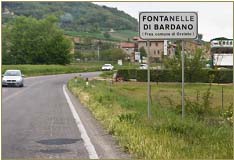Locating the exact centre of a country is always cause for debate due to the complexity and method of calculation, the fact that erosion causes the position to change over time and moreover, because technology is advancing so rapidly in the field of geographic information systems and measurement tools. According to the latest study by Dutch Kadaster, the geographical centre of Italy lies in Fontanelle di Bardano, Orvieto. We went in search of it armed with a GPS.
There are at least four places which claim to be the geographical centre of Italy: Foligno, Monteluco, Rieti (photo below) and Narni. The latter two both have plaques and a small monument as testament to this. But, can any of these towns still claim to be the heart of the country?

In June 2008, the Dutch Land Measuring Authority Kadaster calculated the centres of each European country using ESRI and Safe software. Their recent studies of Italy pinpointed the centre to an area of an industrial estate in Fontanelle di Bardano. To be precise it puts the centre at grid reference 12.0809380292276 42.744388161339.
A global positioning system, which uses satellites to locate exact co ordinates, showed this point to be on the edge of the grounds of a flour factory. The latest topographic measuring technology claims to be the most accurate method to date and is available through EuroGeographics.
Social and Cultural Geography
Henrik Jan Haarink and Esther Kokmeijer, two Dutch geographers are visiting each of the 27 countries of the European Union as part of a project, sponsored by Kadaster, to discover how people live and what lies at the centre of each nation.
" We're interviewing the people who live in the houses nearest to the centre," explains Esther, "finding out about their habits, culture and the characteristics that make their living space feel a home to them."
The photos, stories and interviews together with Kadaster's calculations will be published in a book revealing the diversities and similarities throughout Europe. The book will be launched in February 2010 and exhibitions will then be held in each country of the European Union. A programme with workshops, lectures and debates will be organized in collaboration with local art and architecture institutions to display and discuss the findings.
"We want a broad audience to reflect on the way of life in other countries, in order to establish a better mutual understanding of each other's culture and traditions, especially now that Europe is fast on its way to becoming a unified whole", she says.
So why carry out the research in one of the nearest houses to the centre?
"These points are, on average, the furthest away from the borders of a country. Therefore we believe that this spot is least affected by foreign influences, the purest, the heartbeat of that culture," says Henrik Jan, geographer and architect.
The Cantini's house is the closest to the centre of gravity in Italy.
Mr and Mrs Cantini, aged 71 and 63, said they were surprised to learn their house was just 450 metres from the centre and were happy to be part of the study. Their daughter, Rita Cantini, 34, shop assistant, said: "it's great to know our house is special. We like it here because it is green and peaceful. We grew up here".
Henrik Jan adds: "It's been fascinating so far. We've seen how so many people are attached to the area in which they live because of the history or memories they have there. The architecture and decor of a home have an important role too. We would like to thank the Orvieto Police Department for all their help during our field work".
The book will be a sequel to their last study A Summary of the World published in 2008, after they visited the exact centres of gravity of each continent and compiled their findings. A journey of 15 months to 46 countries.
An intriguing addition to the tourist trail
The appeal of visiting the exact centre of a country, however it is measured, is admittedly fascinating. For many people it is a worthy detour.
Have you gone out of your way to find the ‘centre' in Foligno, Narni, Rieti, Monteluco or in another country?
Do you believe Kadaster's claims? Should Bardano have a plaque too?
Please let us know your views by leaving a comment below
 orvietonews.it by http://www.orvietonews.it is licensed under a Creative Commons Attribuzione - Non commerciale - Non opere derivate 3.0 Unported License.
orvietonews.it by http://www.orvietonews.it is licensed under a Creative Commons Attribuzione - Non commerciale - Non opere derivate 3.0 Unported License.

